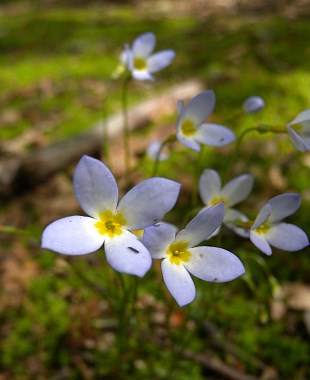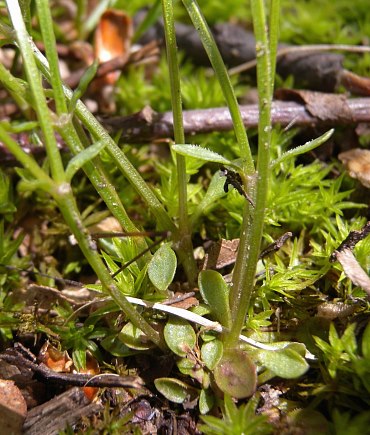Description: This small perennial wildflower is about 3-6" tall, consisting of a rosette of basal leaves and one or more flowering stems with opposite leaves. The basal leaves are about ½" long, medium green, elliptic or oblanceolate in shape, glabrous, and smooth along their margins. The unbranched stems are light green, 4-angled, glabrous, and more or less erect. The opposite leaves, which are widely spaced along each stem, are ¼" long or less, medium green, linear-elliptic in shape, glabrous, sessile, and smooth along their margins. Each stem terminates in 1-2 flowers (usually only one). The flowers have slender pedicels that are light green and glabrous. Individual flowers are 3/8" (10 mm.) across, consisting of a light green tubular calyx with 4 linear lobes, a narrowly tubular corolla with 4 petal-like lobes, 4 stamens, and a pistil with a single style that is bifurcated at its tip. The petal-like lobes of the corolla are pale blue-violet (rarely white), ovate in shape, and widely spreading. At the base of the lobes, the corolla is yellow.

Two types of
flowers are produced: those with long stamens and a short style, and
those with short stamens and a long style. Regardless of the flower
type, both stamens and style are inserted within the corolla or barely
visible at its mouth. The blooming period occurs during the late spring
and lasts about 3 weeks. The flowers are replaced by 2-lobed
seed-capsules about 1/8" (3 mm.) across. The capsule contains several
small
seeds with minute pebbly surfaces (when viewed under magnification).
This wildflower has shallow fibrous roots and slender rhizomes, forming
tufts of flowering plants.
Cultivation:
The preference is full or partial sun, moist to dry-mesic conditions,
and either sandy or thin rocky soil that is somewhat acidic. Most
growth and development occurs during the spring. This wildflower will
adapt to rock gardens.

Range &
Habitat:
The native Quaker Ladies is found along the easternmost tier of
counties and scattered areas of southern Illinois (see Distribution
Map). It is an uncommon species in this state. Habitats
include sand prairies, sandy savannas, sandy paths in wooded areas,
sandstone glades and ledges, and damp rocky areas along upland streams.
This wildflower occurs in higher quality habitats with sparse ground
vegetation.
Faunal Associations:
The flowers of Quaker Ladies attract Little Carpenter bees (Ceratina
spp.), Green Metallic bees and other Halictid bees, bee flies
(Bombyliidae), and small butterflies. Blanchon
(1901) observed the butterfly Boloria bellona
(Meadow Fritillary) as a frequent visitor of the flowers. Both nectar
and pollen are available as floral rewards. According to Covell
(1984/2005), Houstonia spp. (Bluets) are host
plants for caterpillars of the moth Thyris maculata
(Spotted Thyris). It is doubtful that mammalian herbivores make much
use of the foliage of Quaker Ladies, considering its low stature and
sparseness.

Photographic
Location:
A mossy path in a sandy woodland in NW Ohio near the Oak Openings
region.
Comments:
This wildflower is dainty, delicate, and wonderful. It is perhaps the
most aesthetically pleasing of the small wildflowers in its genus. In
Illinois, Quaker Ladies can be distinguished from other Bluets (Houstonia
spp.) by the patch of yellow at the center of its corolla. In
addition, the opening of its corolla is more narrow than most Bluets
and the lobes of its corolla are relatively larger in size and more
widely spreading. A species that does not occur within the state,
Mountain Bluets (Houstonia serpyllifolia), shares
these characteristics with Quaker Ladies. Mountain Bluets differs by
having oval-shaped basal leaves that creep across the ground. This
latter species is found primarily in the Appalachian mountains. Other
common names of Houstonia caerulea are Azure Bluets
and Innocence.